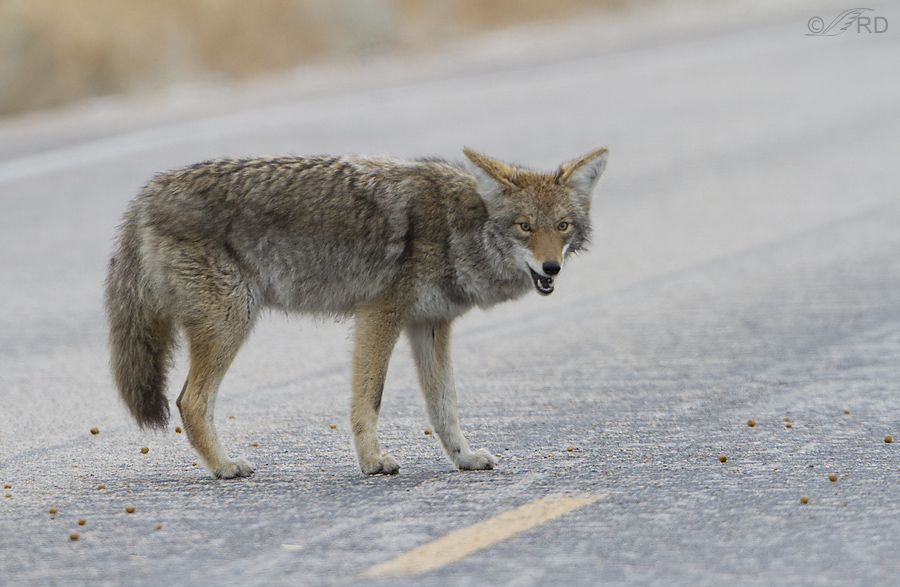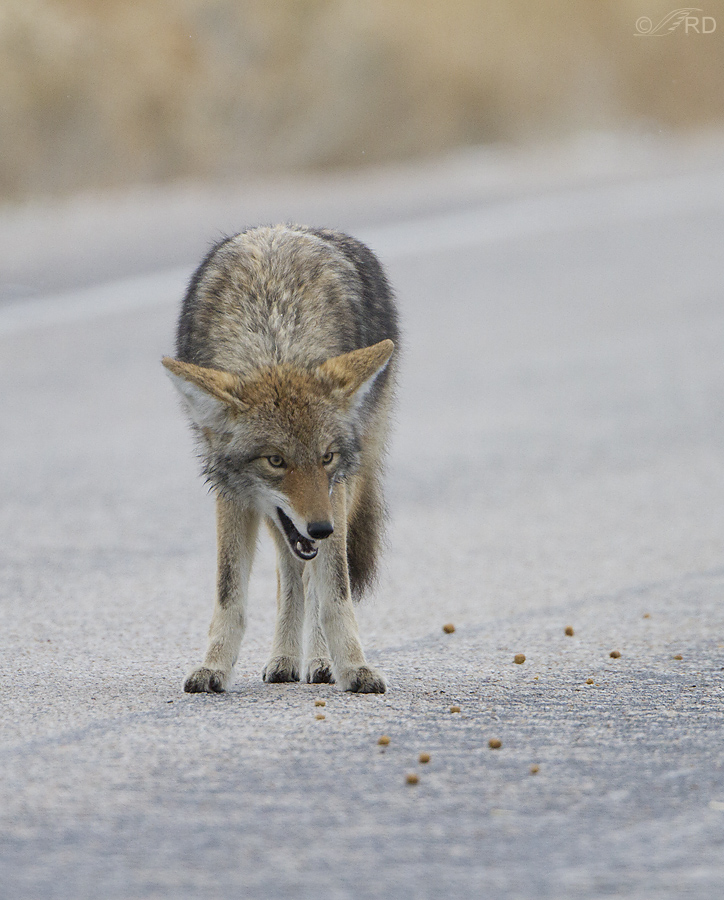I’m of the strong opinion that baiting wild animals of any kind for photographic purposes (or most any other purpose, with very few exceptions) is a despicable practice. It often puts the critter at risk in a variety of different ways and no photo is worth that. I’ve railed against baiting before on this blog so I won’t go into all the details once again here. But this morning I saw another example of why I despise this practice so much.
The weather has been dreary and overcast for so long that I haven’t been out photographing for a while, but this morning we decided to head for Antelope Island just to get “out there” and ease our cabin fever a little, despite the clouds.

As we came around a small curve on the island we noticed this coyote in the middle of the road. I could hardly believe it when I saw that it was feeding on dog food that someone had obviously spread down the center of the road in an attempt to lure coyotes up close and into an area where they wouldn’t be obscured by vegetation. And it worked!

Even as close as we were, the coyote was intent on eating all of the dog food before it left the area. After taking a few documentary photos I drove up to the spot and then we picked up the kibbels and threw them away from the road (we probably should have taken them with us but I didn’t think of it at the time). We then reported what we saw to a ranger and showed him a few of these images and some of the dog food. He said that they will be keeping an eye out for this kind of behavior from visitors to the island in the future. I hope they catch whoever’s responsible and throw the book at them.
The potential negative effects of baiting animals close to the road is obvious. Dog food would likely attract a variety of animals and birds to the road, including coyotes, badgers, bobcats, magpies and who knows what else. Roadkill waiting to happen. And besides, feeding wildlife is very seldom a wise practice. There are very good reasons why it is nearly always discouraged and often illegal.
Ron


Sad, bad, and WRONG. No photo is worth risking the life of the animal – much less of all the animals that dog food/cat food is likely to attract. Thank you for your very responsible actions in both moving the kibble and in reporting it.
I live in Western N.C. where not so long ago Coyotes were brought in to help control the Deer population. So far I’ve only seen 2 any where near my home, Friends have reported seeing pairs with pups, they’re beautiful Animals. The problem with the Coyotes being put in rural residential areas is the same results, they’re being hit and killed by vehicles. I saw a large gorgeous Male Coyote on the Interstate dead last week, it was very disturbing to see. Thank you Ron for reporting the baiting, it’s a very senseless act. I would much rather see them running through a Field or on a trail in the woods.
A very interesting comment, Nola. I’m curious about the rational of bringing in coyotes to control deer populations. I would assume (assuming is always dangerous) that this decision was made by competent wildlife managers BUT here’s what I’ve seen around here. Though there are many Mule Deer and Pronghorn on the island, the coyotes eat voles almost exclusively (though they do scavenge) and I’ve never seen coyotes threaten adult deer or Pronghorn even though they’re often only a a few yards apart. They sometimes eye each other warily but mostly they ignore each other. Perhaps the coyotes prey on the fawns? Are there any reportable results of this coyote/deer “experiment”? Has the number of deer declined? If so, is that decline reliably attributed to coyotes?
To give you an idea of part of the reason why I’m somewhat skeptical of coyotes controlling deer populations, check out what I photographed last year in the link below. Pronghorn are smaller than deer, yet this lone female Pronghorn not only made sissies out of these two adult coyotes, but she instigated the confrontation.
https://featheredphotography.com/blog/2011/05/28/the-coyotes-and-the-plucky-pronghorn/
I assume your deer are White-tails. Perhaps they’re more vulnerable to coyotes for some reason? Or was the rationale flawed? I’m really curious…
Thanks Ron, for sharing and for reporting this negative behavior to the authorities. I really hope they do catch those responsible and “throw the book” at them. My first thought when reading it was that it was poachers; a pretty lazy and dangerous way to get their “prize,” hoping for road kill.
Thanks, Deb. I seriously doubt it was poachers hoping for road kill. I suspect it was just someone who wanted to get close to coyotes for whatever reason. Someone who doesn’t think about or care about the potential consequences of baiting.
Hello Ron,
Was that today? If it was I didn’t notice it but there was a dark Nissin pickup there before light coming back from the gate. I will keep an eye out because they are not helping the animals by doing this. I was wondering if they are poaching for the bounty.
I agree this is not good. I just wanted you to know it wasn’t me and thanks for letting people know about it.
Earl, yes – it was today. Soon after we talked to you, within a couple of hundred yards of the closed gate going to the ranch (they were late opening it). I suspect they were baiting for photography but don’t know for sure. There was also a little red Suziki SX4 down there acting a little suspiciously but it may or may not have been involved. The thought of anyone trying to poach for bounty in a state park makes me sick. Who knows though, after the bounty on coyotes was just doubled to $50 for a pair of ears..
I doubt that we’d have noticed the dog food either, if the coyote hadn’t been there munching it down.
And no, we didn’t think for a minute that it might have been you.
Tell me why do they have a bounty for coyote?
Charlotte, because coyotes on public lands in the west (BLM, Forest Service,etc) occasionally kill livestock, especially sheep – coyotes are considered “vermin” and can be killed wantonly by virtually anyone, by most any method and in most places. These are PUBLIC lands, mind you, belonging to you and I, but the livestock lobby has unbelievable influence in most western states. These livestock folks generally have grazing rights on those lands. I don’t agree with the policy but that’s the way it is. A state park is one of the very few places coyotes are protected.
More here – but think about it before you go here. If you’re like me it’ll only make you very angry.
http://www.care2.com/causes/utah-doubles-bounty-for-coyotes.html
There sould be counts and limits it seems to me.
I hope they catch them whoever they are. Too bad they can’t set a bait for them!
Thanks for sharing this, and for being a responsible citizen!
I can understand the temptation (to baiting), but not the actual doing so… especially in the middle of a road! What is this person thinking?!
There’s the obvious and immediate danger of an injury, or death – to motorists not just the animal, but the resulting habituation, makes it even worse.
Long after the photographer has left with his/her “catch”, that animal will have lost some wariness of roadways and may seek them out in its search for food.
It will eventually get hit, causing pain and perhaps suffering, not just the animal’s, but also to the unfortunate driver, and passengers. Then the resulting carcass will
attract more creatures to a place they need to avoid.
I love all our furry beings, and just hate seeing them anywhere near roads. Yesterday, on my way to work, I had to slow down for a little weasel running across the highway, just like the one in the photos. Their lives are hard enough without us.
Exactly, Angie. Habituation is especially what the ranger wanted to avoid, for reasons you mention.
The photos are your usual magnificent ones. The message extremely critical. I had no idea that dog food would attract animals. Why wouldn’t people who want to do this put it somewhere safer for the animals and better for photo? Guess I don’t understand why anyone would put “critters” at risk.
Charlotte, coyote hunters, trappers and some ranchers often use dog food to bait coyotes in. Magpies are notorious for stealing it from back porches when dog food has been put out. I’m sure that many carnivores and omnivores would be attracted to it.
I had no idea.